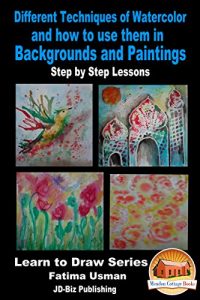Table of Contents
Introduction
History of Water Colors
Importance of Water color techniques
Materials Needed for Water Color Painting
Material for Drawing
Tracing Paper
Water colors
Paper
Pallet
Brushes
Masking Fluid
Containers
Tissue Paper
Board
Masking Tape
Hair Dryer
Mist Sprayer Bottle
Materials Used For Techniques
How to use the following techniques for Painting Backgrounds
Lesson #1 Wet on wet
Lesson #2 Pallet Knife
Lesson #3 Salt
Lesson #4 Gradient
Lesson #5 Rice Texture
Lesson #6 Itching
Lesson #7 Salt Water
Lesson #8 Doily Paper
Lesson #9 Cellophane Texture
Lesson #10 Sprinkles
Lesson #11 Resistance Technique
Lesson #12 Straw Blowing
How to make Beautiful Paintings Using the Techniques
Lesson #13 Dreamy Architecture
Lesson #14 My Flower Garden
Lesson #15 Bird taking off
End Word
Artist Bio
Publisher
Introduction
Watercolors have many techniques. All of them are beautiful. Some are easy and some are difficult to control. But with practice, you can get hold of every technique. Most of the techniques give a tie and dye effect. If you can control these effects, you can make beautiful backgrounds and even create beautiful art works through these techniques. These techniques can be used in many different places to give different effects for example making water stream with the help of salt. I am going to teach you different techniques and how you can create beautiful paintings through them.
This book contains activities by which you will learn to control your color, brush strokes, and many other things. Here I hope I will be able to transfer as much knowledge as I possibly can in a detailed manner. If you were in a class, I would be open to questions. But that is not the case in our situation, so I want to make sure that by the time you finish this book, you won’t have any questions left. I am keeping the struggles in my mind, that I made just to learn this technique and how I wished I could get one person or a single book that could be my fairy god mother and teach me everything I needed to know in a wave of a wand. That didn’t happen of course. But I did learn and now that I know, I want to transfer my knowledge to you.
You will get a chance to play with colors and many different materials. In the end you will be amazed by how we can merge these techniques and turn them into amazing paintings. Even a beginner can learn from this book and turn these techniques into paintings by following the steps.
Introduction
History of Water Colors
Importance of Water color techniques
Materials Needed for Water Color Painting
Material for Drawing
Tracing Paper
Water colors
Paper
Pallet
Brushes
Masking Fluid
Containers
Tissue Paper
Board
Masking Tape
Hair Dryer
Mist Sprayer Bottle
Materials Used For Techniques
How to use the following techniques for Painting Backgrounds
Lesson #1 Wet on wet
Lesson #2 Pallet Knife
Lesson #3 Salt
Lesson #4 Gradient
Lesson #5 Rice Texture
Lesson #6 Itching
Lesson #7 Salt Water
Lesson #8 Doily Paper
Lesson #9 Cellophane Texture
Lesson #10 Sprinkles
Lesson #11 Resistance Technique
Lesson #12 Straw Blowing
How to make Beautiful Paintings Using the Techniques
Lesson #13 Dreamy Architecture
Lesson #14 My Flower Garden
Lesson #15 Bird taking off
End Word
Artist Bio
Publisher
Introduction
Watercolors have many techniques. All of them are beautiful. Some are easy and some are difficult to control. But with practice, you can get hold of every technique. Most of the techniques give a tie and dye effect. If you can control these effects, you can make beautiful backgrounds and even create beautiful art works through these techniques. These techniques can be used in many different places to give different effects for example making water stream with the help of salt. I am going to teach you different techniques and how you can create beautiful paintings through them.
This book contains activities by which you will learn to control your color, brush strokes, and many other things. Here I hope I will be able to transfer as much knowledge as I possibly can in a detailed manner. If you were in a class, I would be open to questions. But that is not the case in our situation, so I want to make sure that by the time you finish this book, you won’t have any questions left. I am keeping the struggles in my mind, that I made just to learn this technique and how I wished I could get one person or a single book that could be my fairy god mother and teach me everything I needed to know in a wave of a wand. That didn’t happen of course. But I did learn and now that I know, I want to transfer my knowledge to you.
You will get a chance to play with colors and many different materials. In the end you will be amazed by how we can merge these techniques and turn them into amazing paintings. Even a beginner can learn from this book and turn these techniques into paintings by following the steps.






